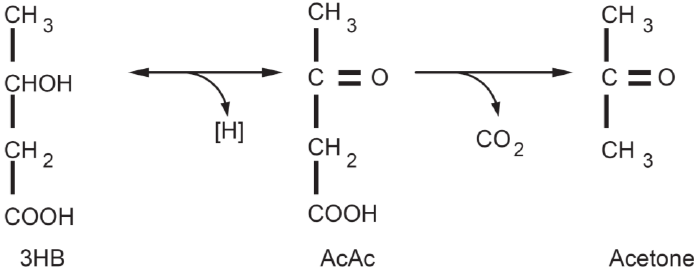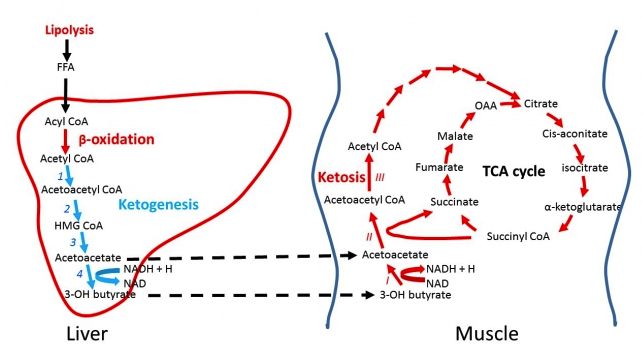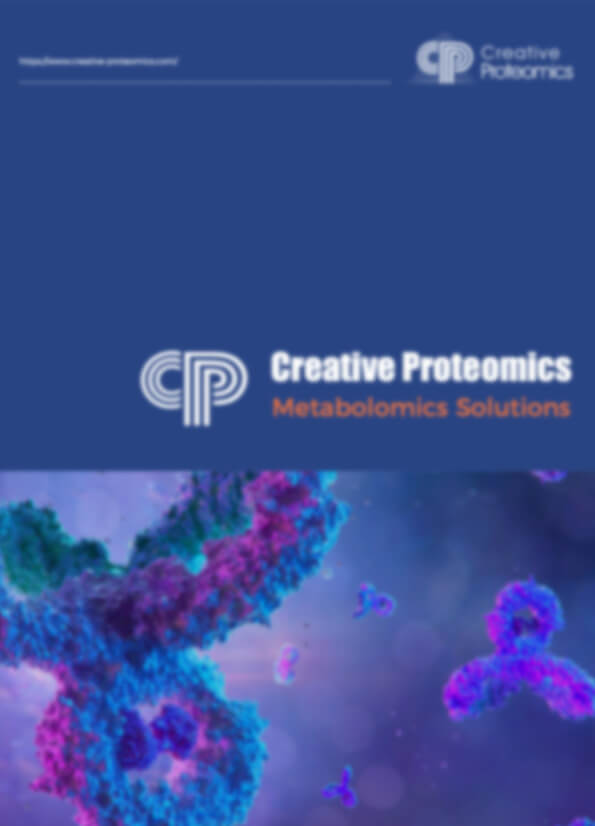- Service Details
- Case Study
- FAQ
What are Ketone Bodies?
Ketone bodies are molecules produced by the liver from fatty acids during periods of low glucose availability in the body. They serve as an alternative energy source, particularly when glucose levels are low, such as during fasting, prolonged exercise, or on a low-carbohydrate, high-fat ketogenic diet. The three main ketone bodies synthesized in the liver are:
- Acetoacetate: This is the first ketone body produced in the pathway of ketogenesis. It can be converted to either beta-hydroxybutyrate (BHB) or acetone.
- Beta-hydroxybutyrate (BHB): BHB is the most abundant ketone body in the bloodstream. It can be converted back to acetoacetate for energy production or used directly by tissues for energy.
- Acetone: Acetone is a volatile ketone body that is produced in smaller quantities compared to acetoacetate and BHB. It is mainly excreted through the breath and urine.
These ketone bodies play a crucial role in providing energy to various tissues, including the brain, heart, and muscles, especially when glucose availability is limited. They are important metabolic intermediates that help maintain energy balance during fasting or periods of increased energy demand.
 Figure 1. Ketone bodies.
Figure 1. Ketone bodies.
At Creative Proteomics, we offer comprehensive ketone bodies analysis services tailored to support research and clinical applications. Our state-of-the-art methodologies and expert team ensure precise and reliable analysis of ketone bodies. Our key service offerings include:
- Quantitative Analysis of Ketone Bodies: Precise quantification of key ketone bodies including acetoacetate, beta-hydroxybutyrate (BHB), and acetone, among others, using advanced analytical techniques.
- Identification and Profiling: Comprehensive identification and profiling of various ketone bodies in biological samples to provide detailed metabolic insights.
List of Detectable Ketone Bodies
| Ketone Bodies Quantified in This Service | ||||
|---|---|---|---|---|
| Acetoacetate | Beta-hydroxybutyrate (BHB) | Acetone | Acetoacetic acid | D-beta-hydroxybutyric acid |
| D-3-hydroxybutyric acid | 3-hydroxyisovaleric acid | 2-hydroxybutyric acid | Acetol | Acetylacetone |
| Acetoacetamide | Acetoacetyl-CoA | Acetoacetyl chloride | Acetoacetyl phosphate | Acetoacetylglycine |
| Acetoacetylshikimic acid | Acetoamidin | Acetoaminophen | Acetoarsan | Acetoarsenite |
| Acetoate | Acetoaz | |||
Analytical Techniques for Ketone Bodies Analysis
High Performance Liquid Chromatography (HPLC)
HPLC allows for the separation and quantification of ketone bodies with high sensitivity and specificity. It is particularly effective for analyzing complex biological samples.
Gas Chromatography-Mass Spectrometry (GC-MS)
GC-MS combines the separation capabilities of gas chromatography with the detection power of mass spectrometry, making it a powerful tool for identifying and quantifying ketone bodies with high accuracy.
Liquid Chromatography-Tandem Mass Spectrometry (LC-MS/MS)
LC-MS/MS offers unparalleled sensitivity and specificity in the detection and quantification of ketone bodies. This technique is highly effective for analyzing low-abundance compounds in complex matrices, providing comprehensive profiling of metabolic states.
Enzymatic Assays
Enzymatic assays are used for the specific and rapid quantification of ketone bodies. These assays rely on enzymatic reactions that produce measurable changes, providing quick and reliable results.
Sample Requirements
For the analysis of low molecular weight sugars, sample requirements can vary depending on the specific analytical method and instrument sensitivity. Here's a general guideline for sample types and suggested sample amounts:
| Sample Type | Sample Amount Required |
|---|---|
| Liquid samples (e.g., juices, extracts) | 1-5 mL, depending on sugar concentration |
| Solid samples (e.g., fruits, powders) | 1-5 g, finely ground or homogenized |
| Serum/plasma | 0.5-1 mL |
| Urine | 1-5 mL |
| Tissue | 20-50 mg, finely ground or homogenized |
Delivery
- A detailed technical report will be provided at the end of the whole project, including the experiment procedure, MS/MS instrument parameters.
- Analytes are reported as uM or ug/mg (tissue), and CV's are generally<10%.
- The name of the analytes, abbreviation, formula, molecular weight and CAS# would also be included in the report.
What is Ketone Body Metabolism?
Ketone body metabolism encompasses two main processes: the synthesis of ketone bodies (ketogenesis) and their breakdown (ketolysis). During the transition from a fed to a fasted state, the liver shifts its metabolic focus from utilizing carbohydrates and synthesizing fatty acids to oxidizing fatty acids and producing ketone bodies. This shift is particularly pronounced in uncontrolled diabetes.
In fasting or diabetic states, the liver-derived ketone bodies enter the bloodstream and serve as an energy source for other organs, including the brain, heart, kidney cortex, and skeletal muscles. This is especially critical for the brain, which relies heavily on glucose and lacks substantial alternative energy sources.
The primary ketone bodies are acetoacetate (AcAc) and 3-hydroxybutyrate (3HB, also known as β-hydroxybutyrate), with acetone being a third, less abundant ketone body. These molecules are always present in the blood, with their levels rising during fasting and extended exercise. After an overnight fast, ketone bodies contribute 2-6% of the body's energy requirements, and this can increase to 30-40% after a three-day fast.
When ketone body levels in the blood rise, they spill over into the urine, a condition known as ketonuria. Elevated blood ketone levels are referred to as ketosis. The body can also eliminate acetone through the lungs, giving the breath a fruity odor. Diabetes is the most common pathological condition leading to elevated blood ketones. In diabetic ketoacidosis, high ketone body production is triggered by low insulin levels and elevated counter-regulatory hormones.
Ketogenesis and Ketolysis
Ketogenesis occurs in the liver and involves the production of ketone bodies from fatty acids. During fasting or low carbohydrate intake, fatty acids are mobilized from adipose tissue and transported to the liver, where they undergo β-oxidation to form AcAc and 3HB.
Ketolysis is the process by which ketone bodies are utilized by peripheral tissues. Organs like the brain, heart, and muscles convert ketone bodies back into acetyl-CoA, which then enters the citric acid cycle to produce energy.
Ketone Body Levels and Excretion
Under normal postprandial or overnight-fasted conditions, ketone bodies are present in the blood and urine at negligible levels. However, during prolonged fasting or in decompensated diabetes mellitus, they become significant sources of metabolic energy. In prolonged starvation, arterial concentrations of ketone bodies can rise approximately 70-fold to 10-12 mM, and can reach even higher levels of 30-40 mM in diabetic ketoacidosis.
The development of ketonemia (elevated blood ketones) involves:
- Increased production by the liver.
- Decreased peripheral utilization in muscle.
- Reduced volume of distribution.
Since ketone bodies are not bound to plasma proteins, they are freely filtered by the renal glomerulus and appear in the urine. Normally, after an overnight fast, plasma ketone body concentrations are low, resulting in negligible urinary excretion. However, when plasma levels exceed 0.1 to 0.2 mM, urinary excretion increases, and measurable amounts of ketone bodies appear in the urine.
Understanding these metabolic processes is crucial for managing conditions like diabetes and for optimizing energy utilization during fasting and exercise.
 Figure 2. Interplay between ketone body production (ketogenesis) in the liver and ketone body utilization utilization (ketolysis) in non-hepatic tissue such as skeletal muscle.
Figure 2. Interplay between ketone body production (ketogenesis) in the liver and ketone body utilization utilization (ketolysis) in non-hepatic tissue such as skeletal muscle.
Blood ketone bodies and breath acetone analysis and their correlations in type 2 diabetes mellitus.
Journal: Diagnostics
Published: 2019
Background
Human biological samples like breath, blood, and urine contain volatile organic compounds (VOCs) associated with specific metabolic pathways, serving as biomarkers for diseases and physiological states. Breath analysis, in particular, has gained attention as a non-invasive method for disease diagnosis and metabolic monitoring. Among the VOCs, acetone is highly abundant in normal human breath and has been studied as a biomarker for diabetes and other physiological conditions since the 1950s. While breath acetone correlates strongly with plasma glucose in type 1 diabetes, no such correlation has been observed in adequately controlled type 2 diabetes patients. Breath acetone concentration is also an indicator of ketosis, a metabolic state characterized by elevated ketone bodies in the blood. Monitoring breath acetone could provide a non-invasive alternative to blood tests for glucose and ketone levels, especially for type 2 diabetes patients who require daily monitoring.
Technical Methods
Study Population
- Participants: 30 diabetes mellitus patients and 28 controls, aged 18-60 years.
- Inclusion criteria: Diagnosed with diabetes.
- Exclusion criteria: Non-diabetic with any other chronic illness.
- Ethical approval and informed consent were obtained.
Collection of Samples
- Blood samples: Collected via vein puncture, centrifuged to separate serum, and stored at -80°C.
- Breath samples: Collected in Tedlar™ bags using a two-way non-rebreathing valve, analyzed immediately using HS-SPME/GC-MS.
Biochemical Analysis in the Blood
- Ketone bodies: Analyzed using Abcam® acetoacetate (ab180875) and beta-hydroxybutyrate (ab83390) assay kits.
- Blood glucose: Quantified using Abcam® glucose assay kit.
- Other clinical data: Glycated hemoglobin, total cholesterol, triglycerides, HDL and LDL cholesterol.
Breath Acetone Analysis Using Targeted Metabolomics
- Acetone derivatization: Acetone in breath derivatized with PFBHA to form stable acetone-oxime.
- GC-MS Analysis:
- Instrument: Agilent Technologies model 6890N GC with mass selective detector.
- Column: 30 m × 0.25 mm with 0.25 µm RXi®-5 SilMS.
- Temperature: Initial 60°C, increased to 150°C at 10°C/min, then to 300°C.
- Quantification: Peak at m/z 181 used for acetone-PFBHA derivative.
Statistical Analysis
- Software: SPSS 26.
- Data presentation: Mean ± standard deviation or median (range).
- Correlations: Pearson and Spearman's rank correlations.
- Models: Linear models fitted with breath acetone concentration as response variables.
- Statistical significance: p-value < 0.05.
Results
Biochemical Analysis
- Diabetic patients exhibited higher mean values of acetoacetate (0.09 mmol/L) and β-hydroxybutyrate (0.46 mmol/L) compared to non-diabetic patients (0.05 mmol/L and 0.25 mmol/L, respectively).
- Plasma glucose and total cholesterol were higher in type 2 diabetes mellitus patients than in non-diabetic patients.
- Breath acetone was higher in diabetic patients (>0.8 ppm) compared to non-diabetic patients (<0.8 ppm).
Breath Acetone Analysis
- HS-SPME/GC-MS successfully quantified acetone in breath samples.
- Diabetic patients showed breath acetone concentrations higher than 1.8 ppm, while non-diabetic patients had concentrations lower than 0.8 ppm.
Correlation Studies
- Significant correlations observed between breath acetone and plasma acetoacetate (r = 0.897), and breath acetone and plasma β-hydroxybutyrate (r = 0.821).
- Positive correlations suggest acetone as a viable non-invasive biomarker for diabetes mellitus.
 Scatter plot for plasma blood glucose, acetoacetate, beta-hydroxybutyrate and breath acetone in (a) type 2 diabetic and (b) non-diabetic mellitus patients.
Scatter plot for plasma blood glucose, acetoacetate, beta-hydroxybutyrate and breath acetone in (a) type 2 diabetic and (b) non-diabetic mellitus patients.
 The gas chromatography-mass spectrometry (GC-MS) mass spectrum of acetone-oxime.
The gas chromatography-mass spectrometry (GC-MS) mass spectrum of acetone-oxime.
Reference
- Saasa, Valentine, et al. "Blood ketone bodies and breath acetone analysis and their correlations in type 2 diabetes mellitus." Diagnostics 9.4 (2019): 224.
Q: What are the clinical implications of ketone bodies analysis?
A: Ketone bodies serve as biomarkers and indicators of metabolic health and disease:
- Diabetic Ketoacidosis (DKA): Elevated ketone levels, especially beta-hydroxybutyrate and acetoacetate, are critical diagnostic markers of DKA, a serious complication of diabetes characterized by hyperglycemia and metabolic acidosis.
- Ketogenic Diets: Monitoring ketone levels helps assess the metabolic state induced by ketogenic diets, aiding in dietary management for conditions like epilepsy, obesity, and metabolic syndrome.
- Metabolic Disorders: Changes in ketone body metabolism can reflect metabolic dysregulation in conditions such as insulin resistance, mitochondrial disorders, and certain genetic metabolic diseases.
Q: How do ketone bodies contribute to energy metabolism?
A: Ketone bodies play a crucial role in energy metabolism by serving as alternative energy substrates:
- Energy Production: Ketone bodies are converted into acetyl-CoA in the mitochondria, which enters the citric acid cycle (Krebs cycle) to generate ATP. This process provides energy for tissues, especially the brain and muscles, during periods of fasting, starvation, or prolonged exercise.
- Metabolic Flexibility: Ketone bodies allow the body to adapt to varying energy demands and nutrient availability, supporting energy homeostasis and preserving glucose for organs with strict glucose dependency.
Q: What are the methods for preparing samples for ketone bodies analysis?
A: Sample preparation methods ensure accurate and reliable ketone body analysis:
Extraction Techniques: Liquid-liquid extraction, solid-phase extraction, or protein precipitation methods isolate ketone bodies from biological fluids, removing proteins, lipids, and other interfering substances.
Derivatization: Chemical derivatization enhances ketone body stability and analytical sensitivity in GC-MS analysis, facilitating quantification and identification of individual ketone forms.
Quality Control: Implementing quality control measures, including internal standards and calibration curves, verifies assay accuracy and precision, ensuring robust ketone body quantification in research and clinical settings.






